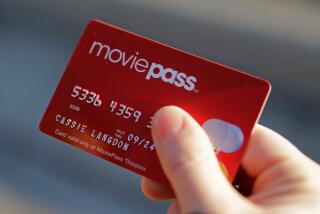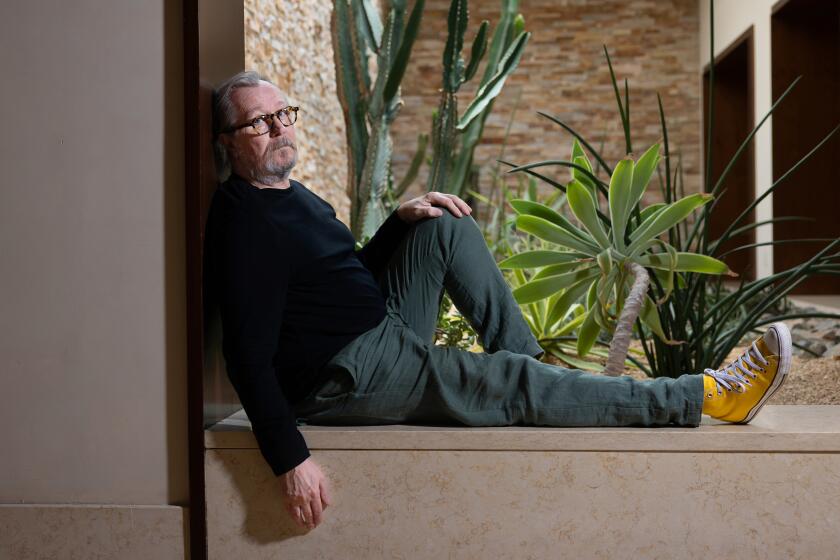Now playing at a living room near you
Struggling to compete with big-budget movies at the box office, indie films are increasingly finding a lucrative niche in one of Hollywood’s fastest-growing markets: video on demand.
The number of films released in theaters and video on demand at the same time nearly doubled from 2009 to 2011 and is projected to jump about 30% this year, to 68.
The dark comedy “Bachelorette” exemplifies the trend: It has grossed about $5.5 million from video-on-demand (or VOD) rentals since premiering in August, compared with a paltry $418,000 earned in theaters.
PHOTOS: Celebrities by the Times
“It has become harder to generate revenue from independent movies [in theaters] and VOD is our next best option,” said Kevin Iwashina, managing partner of film production and sales company Preferred Content. “This is how we’re putting a Band-Aid on our business.”
Since the advent of videocassettes in the 1980s, film fans typically had to wait at least three months after a movie opened at a local cinema until they could rent it at home through cable or the Internet.
But in a market with theatrical advertising costs rising, DVD sales plummeting and the local multiplex dominated by films about superheroes and cartoon animals, independent movie producers are desperate for alternatives. With VOD, the returns may be smaller than for a box office smash, but the odds of turning a profit are higher.
In addition to “Bachelorette,” other recent VOD hits include last month’s critically acclaimed drama “Arbitrage,” starring Richard Gere. And late last year the simultaneous VOD/theatrical release “Margin Call,” an independently financed picture about the financial crisis, was a critical and commercial success and earned an Academy Award nomination for original screenplay.
Nonetheless, many filmmakers remain skeptical that VOD can bring them the same prestige, not to mention profits, as the big screen, where quality movies have always premiered.
“The perception is that VOD movies are crappy,” said director Derick Martini, whose film “Hick,” starring Blake Lively, was released in theaters and on-demand in May. “Your work can be seen by so many more people, but filmmakers don’t make movies for the small screen.”
When “This American Life” host Ira Glass and comedian Mike Birbiglia teamed up to make the comedy “Sleepwalk With Me,” they expected it would play in theaters nationwide. After all, Glass’ radio show attracts 2 million listeners each week, and Birbiglia routinely sells out large venues for his stand-up shows.
After its premiere at this year’s Sundance Film Festival, however, distributors said they would buy the picture only if they could do a simultaneous VOD release. “Our fan base impresses no one,” Glass said.
Embracing their fate, the duo planned to encourage fans to order “Sleepwalk With Me” on-demand in August by participating in pizza parties via Skype. But after the movie got a wider theatrical release than originally planned — 146 theaters instead of 34 — the duo killed the idea.
“We’re nixing the pizza party thing for now because we don’t want to remind people that they might be able to find [the movie] on VOD,” Glass wrote in an email. “If they find it, fine. But for now, since we’re actually going to be in theaters, we’re going to try to push people to theaters.”
Distributors of independent movies, meanwhile, very much want consumers to find the higher quality offerings available on VOD. And they want to change the minds of the filmmakers who remain resistant.
“There are definitely still people who resist and say the only kind of deal they will do is a traditional release,” said Jason Janego, co-president of the Weinstein Co. unit Radius-TWC, which specializes in multi-platform releases. “We hope more people will become open-minded and realize the potential.”
The numbers make clear that releasing an independent movie on the big screen is a high-stakes gamble with long odds. So far this year, only six out of 274 movies that opened in a handful of theaters expanded to more than 600 locations, the threshold commonly used to define a “nationwide” release, according to Hollywood.com.
“The statistics are extremely sobering,” said Tom Quinn, Janego’s Radius-TWC partner. “The traditional model only makes sense anymore if you believe in your heart of hearts that your movie will gross more than $20 million.”
With VOD, viewers pay $5 to $10 to stream the film from their cable or satellite TV provider, or digital stores such as iTunes or Amazon.com.
REVIEW: ‘The Bachelorette’
Unlike box office receipts that are widely shared through a database to which all studios subscribe, VOD data are tightly held. Companies release statistics only when the numbers are sensational, as with Radius-TWC’s “Bachelorette.”
“It’s very frustrating that we don’t get clear numbers the way we do with box office,” said Laura Kim, a partner at independent distributor Red Flag Releasing.
On average, insiders say, studios consider a low-budget VOD release a success if it’s rented more than 50,000 times, which translates to $250,000 to $500,000 in gross sales. A similar number would be a flop at the box office, but advertising costs for VOD are a fraction of what’s needed for a theatrical release.
The best marketing for a VOD movie, in fact, is simply putting it in theaters. VOD providers highlight movies still playing in theaters in a special section and charge up to $10 for them, compared with $5 or less for ones that have finished their theatrical runs.
“The theatrical part of these releases are something of a hoax,” said Martini. “You can justify a higher price so long as it’s playing in one theater in Timbuktu.”
In addition, most major newspapers — including the Los Angeles Times — review only movies that play in theaters.
There are real trade-offs, though. Choosing an early video-on-demand release can mean foregoing any chance of box office riches. Major chains including AMC Entertainment and Regal Cinemas, which control most of the nation’s movie screens, won’t play a film if it’s available in homes sooner than 90 days after it opens on a big screen.
Eager to protect their relationships with exhibitors, major studios follow the same policies and don’t put much marketing muscle behind early VOD releases.
PHOTOS: Celebrities by the Times
In June, 20th Century Fox’s prestigious specialty label Fox Searchlight formed an unusual partnership for “The Do-Deca-Pentathlon,” a comedy directed by brothers Jay and Mark Duplass.
In order to keep its hands clean and avoid upsetting the theater chains, Searchlight recruited Red Flag to release the movie in theaters while it handled VOD. Mark Duplass said he was happy with the compromise. He and his brother’s most successful movie, “Cyrus,” grossed only $7.5 million in theaters and the experimental “Do-Deca” had much dimmer commercial prospects.
“I believe that movie would lose money if Searchlight put it out the regular way,” said Mark Duplass. “I have no problem with people watching ‘Do-Deca’ at home — it’s more financially responsible and will give us a wider reach. That’s a win-win for me.”
PHOTOS AND MORE:
PHOTOS: Hollywood back lot moments
Latest movie reviews
PHOTOS: NC-17 movies: Why they got the rating
More to Read
From the Oscars to the Emmys.
Get the Envelope newsletter for exclusive awards season coverage, behind-the-scenes stories from the Envelope podcast and columnist Glenn Whipp’s must-read analysis.
You may occasionally receive promotional content from the Los Angeles Times.









